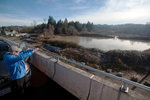


This week didn’t get off to a very good start for residents and workers in downtown Centralia.
The city saw 2.6 inches of rain ending Monday, causing China Creek to overflow, City Hall to flood and a lot of water to linger in the streets for a couple days.
But, if things go as planned, events such as this week’s urban flooding will be much less common.
The city of Centralia wants to reshape a portion of China Creek to minimize flood impacts on the downtown area during all but the most severe rain events.
The idea behind the China Creek project is to slow the surge of water before it gets to the culverts below the city. Like a freeway onramp at rush hour, the decades-old concrete tunnel below the city is a bottleneck point for the water draining off the urban area and the water coming in from further upstream. When the channels get maxed out, the water backs up into the streets around downtown. But, by slowing the upstream flows, officials hope they can create enough space for the downstream waters to drain off first.
“To store the water up here would take some of the pressure off,” said Centralia Public Works Director Kahle Jennings while standing at one of the project sites above the Logan District. “Instead of a single humped camel we’ll have a two humped camel of lower intensity.”
The project will come in two phases that are expected to be completed in 2015 and 2016, respectively. Between the two storage sites, officials predict they will be able to store between 50 and 60 acre-feet of water.
“We could get a 6 to 7, maybe 9 inch drop (in China Creek),” Jennings said. “That’s truly significant.”
Phase one is on 39 acres of land along Little Hanaford Road the city purchased in 2004. The other phase will be done in the Agnew Ponds area that was donated to the city in 2013. In October, the Centralia City Council approved a contract with ENVIRON International Corp. to begin initial work on the flood mitigation projects.
The plan for the Little Hanaford Road site draws its inspiration from a similar wetland project in Portland, Oregon. Right now, the creek flows through the property in a straight line and unimpeded by much vegetation. Instead, the city is partnering with the Chehalis Tribe to make the creek meander through the property and make the area hospitable to fish. The creek will be surrounded by trees and lined with aquatic plants and wood debris that will slow the water down. When flows get too large for the creek, it’ll spill into several large pools.
“Right now there’s nothing to stop this water from flowing in the field,” Jennings said. “But by creating some topography and making the creek bend around these structures that’ll slow it down, too.”
The second part will be at the Agnew Ponds where a natural control structure, probably a berm, will store even more water in the area than it already does.
“Storing 10 acre-feet of water here would reduce that flow downtown by about 3.5 inches,” Jennings said.
Here, though, there is the possibility it could adversely affect landowners near the ponds. Jennings said he has already received comments from people living in the area worried that their property could flood more severely than it already does.
“I think it’s a fair concern,” Jennings said. “We’re not in the business doing things that harm people. We want to do things that don’t harm people. It’s something I think we’ll have to factor in and we may have to mitigate it.”
The project isn’t a panacea for flooding on China Creek. It’ll do nothing for the woes of the citizens dealing with flooding at the lower end of the creek (near Cedar Creek Park, for example) where flood levels are dictated by the Chehalis River.
“Where the Chehalis backs up into China Creek, that’ll still happen,” said Stormwater Operations Manager Kim Ashmore. “When China Creek comes up, it does its thing and then recedes before the Chehalis or Skookumchuck have even crested.”
The costs of the project is yet to be determined.
Jennings said he requested $900,000 from the Chehalis River Basin Flood Authority, but the true costs of the project won’t be known until the project design work is complete.
The China Creek project was number four on the Flood Authority’s $17 million local flood control projects budget as part of its multifaceted proposal it sent to the governor’s office. In his budget, Gov. Jay Inslee instead agreed to $10 million for local flood reduction and habitat projects and $20 million for larger projects in the Chehalis Basin.
Still, officials say they’re optimistic that the China Creek project will receive funding.
“There’s a lot of benefits to be seen in the China Creek Project,” said Scott Boettcher, staffer for the Flood Authority. “Even taking off a few inches prevents a lot of storefronts closing.”
The decision of how much money, if any, goes to flood mitigation ultimately rests on what kind of agreement the Legislature and the governor can come to.
“It’s in the Legislature’s hands now,” Jennings said.